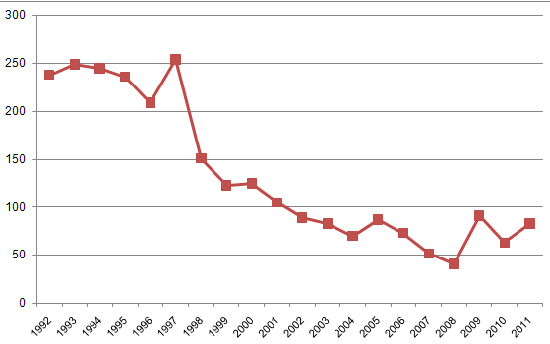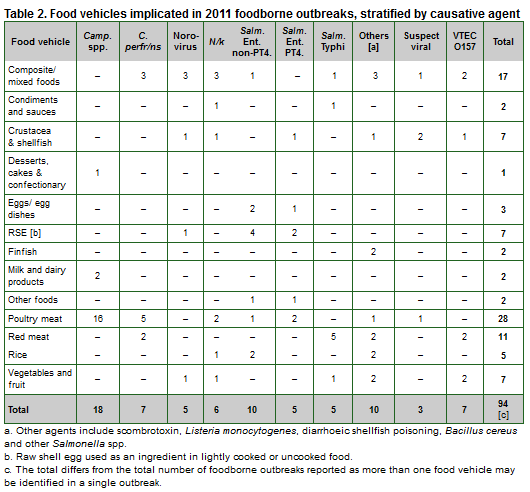



Campy Was Leading Cause of Foodborne Disease in 2011
UK - Eighty three general outbreaks of foodborne infectious disease in England and Wales were reported in 2011 to the HPA's electronic Foodborne and Non-foodborne Gastrointestinal Outbreak Surveillance System (eFOSS).According to a Health Protection Report by the Health Protection Agency, in the previous year there were 63 outbreaks of foodborne diseases (figure 1).
Figure 1. Total number of foodborne outbreaks in England and Wales, 1991-2011

The rise in the number of general outbreaks in 2011 could be due to the continued increase in outbreaks caused by Campylobacter spp (20/83 in 2011; 18/63 in 2010) and a rise in the outbreaks caused by Salmonella spp compared to the previous year (18 in 2011; 8 in 2010).
Outbreaks of campylobacter have increased since 2009 and concurrently campylobacter is now the most frequently implicated causative agent in reported outbreaks representing 24US of all outbreaks [1,2 ]. In 2011, as in preceding years, most campylobacter outbreaks were associated with consumption of undercooked poultry liver pâté or parfait f rom food service establishments [3,4]. Salmonella spp. accounted for 22US of the outbreaks, most of which were caused by an increase in S. Enteritidis non PT 4 (44US, 8/18) or S. Typhimurium (33US, 6/18). The next most frequently identified agents included: norovirus (10US, 8/83), VTEC O157 (10US, 8/83) and Clostridium perfringens (8US, 7/83) (table 1).

A total of 2133 people were affected in these 83 foodborne outbreaks, of which 1066 were laboratory confirmed cases; there were 173 hospitalisations and three deaths. Salmonellas and VTEC O157 accounted for the majority of people affected (595; 28US and 256; 12US respectively), and most of the hospital admissions (75; 43US and 83; 48US, respectively). Campylobacter cases occurring in outbreaks significantly increased in 2009 to 315 cases; a six-fold increase from 42 cases reported in 2008. In 2011, the number of cases reported increased by 37US from 376 cases in 2010 to 518 cases.
Regional distribution of foodborne outbreaks
There was no regional pattern in the distribution of general foodborne outbreaks. Most outbreaks reported were from the East Midlands (12), South East (12), Yorkshire and Humberside (11), followed by London (8), East of England (7), North West (7), South West (7) and West midlands (7). Five outbreaks occurred nationally with one predominantly in the North West.
Breakdown by setting, food vehicle and contributory factors
As in previous years [2,5], most outbreaks occurred in the food service sector (80US, 66/83) and included for example, restaurants, pubs, hotels, event caterers. The remaining outbreaks were either linked to institutional or residential settings (13US; 11/83) – such as prisons and care homes, the community, ie disseminated cases (5US; 4/83) – or retail settings (2US; 2/83) (table 1).
A food vehicle was implicated in 84US (70/83) of outbreaks: more than one food vehicle might be identified in a single outbreak (table 2). Poultry meat (30US; 28/94), composite/mixed foods (18US; 17/94) and red meat (12US; 11/94) were the most frequently identified food vehicles (table 2). Over two-thirds (69US, 16/28) of poultry meat associated outbreaks were caused by campylobacter, and in 94US (15/16) the poultry meat dish was poultry liver parfait or pâté. Composite/mixed foods outbreaks were linked to a range of causative agents including C. perfringens (3), norovirus (3) and VTEC O157 (2), as were red meat outbreaks (S. Typhimurium (5), VTEC O157 (2), C. perfringens (2)). The evidence implicating a food vehicle in outbreaks was: descriptive epidemiology in 49US (41/83) of outbreaks; analytical epidemiology alone in 22US (18/83); descriptive epidemiology with microbiological evidence in 8US (7/83); and analytical epidemiology with microbiological evidence in 5US (4/83).

Cross contamination (37US, 31/83) and inadequate heat treatment/cooking (35US, 29/83) were the major contributory factors in foodborne outbreaks. Other contributory factors included: storage of food too long (19US, 16/83), inadequate chilling (14US; 12/83), infected food handlers (13US; 11/83) and poor hand washing facilities (13US; 11/83).
The eFOSS data for 2011 presented in this article shows that campylobacter, mainly associated with chicken liver parfait or pâté, remains the leading cause of foodborne outbreaks. The majority of all foodborne outbreaks were linked specifically to food service premises, and that these were related to inadequate cooking of the food and/or cross contamination in the kitchen. Caterers need to adopt appropriate control measures and follow food safety advice provided by the Food Standards Agency [6]. Proper cooking, improving hygiene and lowering the risk of introducing pathogens into the food service sector are needed in order to reduce the risk of infection
References
- Health Protection Agency. Campylobacter infections per year in England and Wales, 2000-2010. Available at: http://www.hpa.org.uk/Topics/InfectiousDiseases/ InfectionsAZ/Campylobacter/EpidemiologicalData/campyDataEw/.
- Health Protection Agency. Campylobacter now the leading cause of general foodborne outbreaks in England and Wales. Health Protection Report 5(19), 13 May 2011. Available at: http://www.hpa.org.uk/hpr/archives/2011/news1911.htm#efoss.
- Health Protection Agency. How to spoil a wedding – foodborne campylobacter outbreaks at catering premises and catered event. Health Protection report 5(48), 2 December 2011. Available at: http://www.hpa.org.uk/hpr/archives/2011/hpr4811.pdf.
- Health Protection Agency. Foodborne outbreaks of campylobacter associated with consumption of poultry liver pâté/parfait – spotlight on caterers and food safety. Health Protection Report 4(48), 3 December 2010. Available at: http://www.hpa.org.uk/hpr/archives/2010/news4810.htm#campy.
- Gormley FJ, et al. A 17-year review of foodborne outbreaks: describing the continuing decline in England and Wales (1992-2008). Epidemiology and Infection 2011; 139: 688 – 99.
- Food Standards Agency (FSA) Safer food, better business. Available at: http://www.food.gov.uk/foodindustry/regulation/hygleg/hyglegresources/sfbb/.











